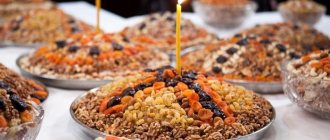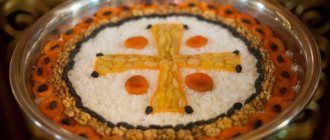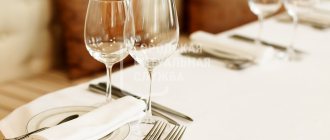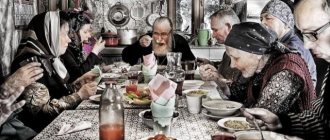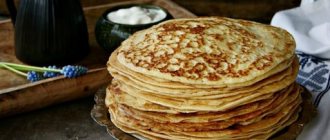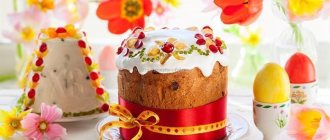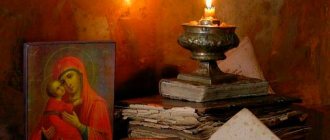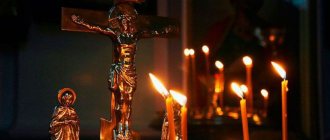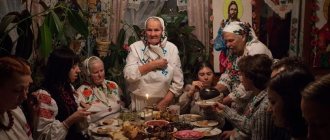Today we are starting a new series of materials - about church “professions”. Maybe they shouldn’t be called professions - first of all, these are obediences, important, necessary. But they are carried out by true professionals in their field, who invest in their work not only skill, but also soul, prayer, and love for God. Often these people are unknown to ordinary parishioners—only the results of their efforts are visible. So, by talking about them and their skills, we not only open the door to the kitchen figuratively, and sometimes literally, but also pay tribute to these hard workers.
Crumbly, aromatic, tasty, it melts in your mouth... There is always a line for it. Sometimes you think: what if you don’t get it, and the opportunity to treat yourself next time will not be soon... No, we are not talking about some scarce delicacy at all - but about koliva, which in many churches of our diocese is prepared for the great and twelfth holidays, on the days of remembrance the deceased and the memory of especially revered saints.
It turns out that kolivo is not common in all regions of Russia, and many, having heard this name, mistakenly imagine kutya, that is, boiled rice with honey and raisins, which is usually prepared for funeral meals. We talked about the secrets of preparing real koliv with Deacon Viktor Sigarev, who has been preparing it at the Intercession Church in Saratov for more than five years.
Intercession of the Great Martyr
The word "kolivo" literally translates from Greek as "boiled wheat." This name is associated with the ancient custom of making memorial offerings of grain and fruit - “kolibo”, but now this dish is prepared not only to commemorate the dead.
The tradition of consecrating the koliva appeared in the Church one and a half thousand years ago and is associated with the name of the Great Martyr Theodore Tiron. Emperor Julian the Apostate ordered that all the products in the market be sprinkled with blood sacrificed to idols, so that pious Christians who did not want to break their fast would, without realizing it, eat desecrated products. During these days, Saint Theodore appeared to the Archbishop of Constantinople in a dream, who warned the bishop about the emperor’s plan and commanded Christians during the days of strict fasting not to visit shopping arcades, but to eat boiled wheat from home supplies - kolivo. In memory of this event, the Church established the rite of consecration of the koliva. It is celebrated in Orthodox churches on Friday of the first week of Lent.
The tradition of preparing koliva on other days of the church year is widespread in Greece, Bulgaria and Serbia and is gradually beginning to be revived in our country. In Saratov, Deacon Viktor Sigarev, then just a parishioner of the Intercession Church, was blessed to do this. The candidacy was not chosen by chance: Victor’s father had studied at a culinary school, and then mastered the profession of an artist-sculptor and worked as a decorator.
“I came to church when I began to read the Bible and understand that there are things in life that are much more important than worldly vanity,” recalls Father Victor. “When I began to become a church member and saw the beauty of Orthodox worship, I began to think about how I personally could serve God. Therefore, when they offered to help in the temple - to do koliv, I was happy. I was interested in trying myself in something new. I didn’t even dare to dream about being ordained then, considering myself an unworthy person. But we do not choose God, but He chooses us, like the apostles from among the fishermen and tax collectors. For me, my consecration is a miracle of miracles!
Our interlocutor had no idea what kolivo was, so he looked for information on the Internet. It took about a year to master the technology, study the nuances, and finally it started to work out.
“For me personally, the most important thing was to understand how to decorate the finished dish, because I started making koliva as an artist rather than as a cook,” says Father Victor. “Although, of course, everything is important in this process, because if it’s beautifully decorated , but it’s tasteless, no one will eat it. While being carried away by creativity, one should not forget about the framework of tradition, so as not to turn kolivo from a church dish into an ordinary dessert.
Kutya is brought to the temple for the funeral table after the blessing it can be eaten
Kutya is brought to the temple in memory of deceased Christians, which is placed on the funeral table with a lit candle. It marks the unfading light of eternal life.
The priest blesses the kutia during the funeral service, and then this kutia is eaten at the funeral table with prayerful remembrance of the deceased. Kutya is eaten before regular food.
Before eating kutya or kolivo, it must be brought to the temple and placed on the funeral table. A lit candle is usually placed in kutya. After the funeral service, which the priest serves, he blesses the food. Only after this can kutya and kolivo be eaten by all relatives for the deceased servant of God
What do the ingredients that are in the kutia mean? Wheat and rice mean that the dead will be resurrected, just as grain rots in the ground, which then bears abundant fruit.
But honey signifies the sweetness of the eternal blessings of the Kingdom of Heaven. Also, kutya brought to the temple can be left on the funeral table, so that those who prayed for the deceased can eat it.
To the recipe book
The basis of koliva is wheat, and it must be chosen carefully, since its quality has a decisive effect on the taste of the final product. White spring wheat is the best: after processing it becomes softer than other varieties, and at the same time the grain holds its shape and does not become soft.
We asked Father Victor to share the recipe for real coliva.
“The recipe is simple: pour two glasses of wheat into twelve glasses of water, add a little salt and set to cook for 2-3 hours,” he says. “Pour the boiled grain into a colander and rinse with cool running water.” Spread the wheat in an even thin layer on the table - on any clean cloth, and let it dry for 40-60 minutes. After this, pour it into a container. It is better to use brass utensils; do not use plastic, enamel basins or products with ungodly designs. Add to the wheat one glass of coconut flakes, 1/4 cup of black raisins, 1/4 cup of light raisins, 1/2 cup of ground lean cookies, the zest of one lemon, grated on a fine grater, a glass of walnuts, a third of which are finely chopped, and two thirds are ground. Mix all the ingredients thoroughly to obtain a homogeneous crumbly mass, reminiscent of properly prepared pilaf. After this, we level the surface of the koliva and sprinkle with ground wheat bread crumbs - this will remove all unevenness and excess moisture. Through a fine sieve, dust everything with powdered sugar and again with breadcrumbs.
How to cook Kolivo
The process of preparing coliva is not very complicated, but it is not fast. First you need to soak the wheat from the evening of the previous day. Then boil it and dry it. The nuts are cleaned and usually crushed. If necessary, soak the raisins for a few minutes. Roast sesame seeds and flour.
honey was added to kolivo , which soaked the wheat and the mixture was more like porridge. Nowadays they prefer to use sugar or powdered sugar. In some regions, chopped parsley leaves are added to the dish. Cinnamon and cloves are usually used as spices.
Seal
What are we going to draw with?
When you see the face of a saint or an intricate ornament on the surface of a finished koliva, you can’t wrap your head around: how can you create such beauty? Not everyone can depict this with a pencil and paints, but here in general... How, by the way, is all this done?
Drawing is truly the most difficult part of the work. It must comply with Orthodox canons and traditions. It is allowed to add an ornament to the image, which makes it possible to use more colors in the design.
“At first I had one decoration technique - painting with dyes on glaze,” says Father Victor. “But it took a lot of time, 7-8 hours.” Then I learned that on Athos they use colored sugar to create designs. I tried it, but it turned out to be inconvenient to work with, because the crystals are large - you can’t make small parts from them. On Mount Athos, the food is served in large dishes, and the details are correspondingly larger. As color ingredients, I began to use ground poppy seeds, cocoa powder, and spices with a mild taste - sweet paprika, for example. But the moment came when these flowers were no longer enough, and some kind of alternative was needed. So I moved on to colored breadcrumbs. Using food coloring you can create a huge range of colors. I also use natural dyes: for example, I get black from cuttlefish ink.
In Victor’s father’s workshop there are a lot of jars with crackers of different colors - really, you can paint a picture. He prepares edible “paints” in advance. The process is simple: take a loaf of wheat bread, cut off the crust on all sides so that it does not add an additional tone. Cut into small cubes and dry until fully cooked. Then we dilute the food coloring of the desired color in water and immerse the crackers in it. Having painted the crackers in different colors, we dry them again and grind them through a meat grinder into fine crumbs - each color separately. Sift through a fine sieve and pour into containers. Rusk powder should not be stored for very long, as it may go rancid.
“Any person can prepare and decorate kolivo, even those without artistic skills,” explains Father Victor. “The main thing is to be able to hold a pencil and ruler in your hands and be ready for painstaking work.” When I first started doing koliv, I decided to never repeat myself in my drawings. So far it's working. Usually images come to my mind on their own - then I sit down and start drawing. As a rule, this is a cross with some kind of ornament or the face of a saint. Some people are wary of the fact that a saint is depicted on the koliva. But that's the tradition. On Mount Athos, in monasteries, saints are depicted on the koliva very often, and this does not bother anyone.
After the image is invented and transferred to paper, a stencil is made. A circle with a carved cross is placed on the surface of the koliva, and the uncovered space is covered with colored crackers. The rest of the details are applied to the surface of the coliva in the same way.
“The colors should be harmoniously combined with each other,” continues Father Victor. “I try to focus not on the color, but on the plot.” In addition to colored crackers, kolivo can be decorated with any nuts, pomegranate seeds or peeled pumpkin seeds. But, I repeat, this is not a confectionery product, so you shouldn’t add candied fruits, marmalade, or chocolate - this is already too much.
Consecration of kutya and koliva at home is impossible
Many people often ask how to consecrate kutya at home? In fact, kutia and kolivo are not consecrated by people at home. It can only be consecrated by a priest by reading special prayers from the psalter.
If you need to consecrate the kutya, then it would be best to take it to the temple. There the priest will perform a memorial service for your deceased, after which he will bless the kutya. Only then can you take her home.
By leaving a comment, you accept the user agreement
Folk traditions associated with Sochivo
The main Christmas dish, filled with symbols, is associated with many folk traditions.
- During the holiday, the owner of the house took a full spoon of sochiv and threw it to the ceiling. All family members carefully counted the grains stuck to the top. The more grains left on the ceiling, the richer the harvest will be. Each grain stuck to the ceiling is a symbol of the sheaf that God will give in the coming year.
- Spikelets placed under a bowl of koliv were considered a talisman for the home. They were kept for a whole year, until the next holidays.
- Some owners believed so much in the healing power of soch that they fed it to their pets so that they would get sick less and give good offspring.
- At night, a little kutya was left on the table in memory of deceased relatives.
- Children always took kolivo in the evening to their grandparents living separately and to their godparents.
More recipes for Orthodox cuisine:
- Lenten baking recipes
- Lenten pancake recipes
- Recipes for Easter cakes and Easter cakes
